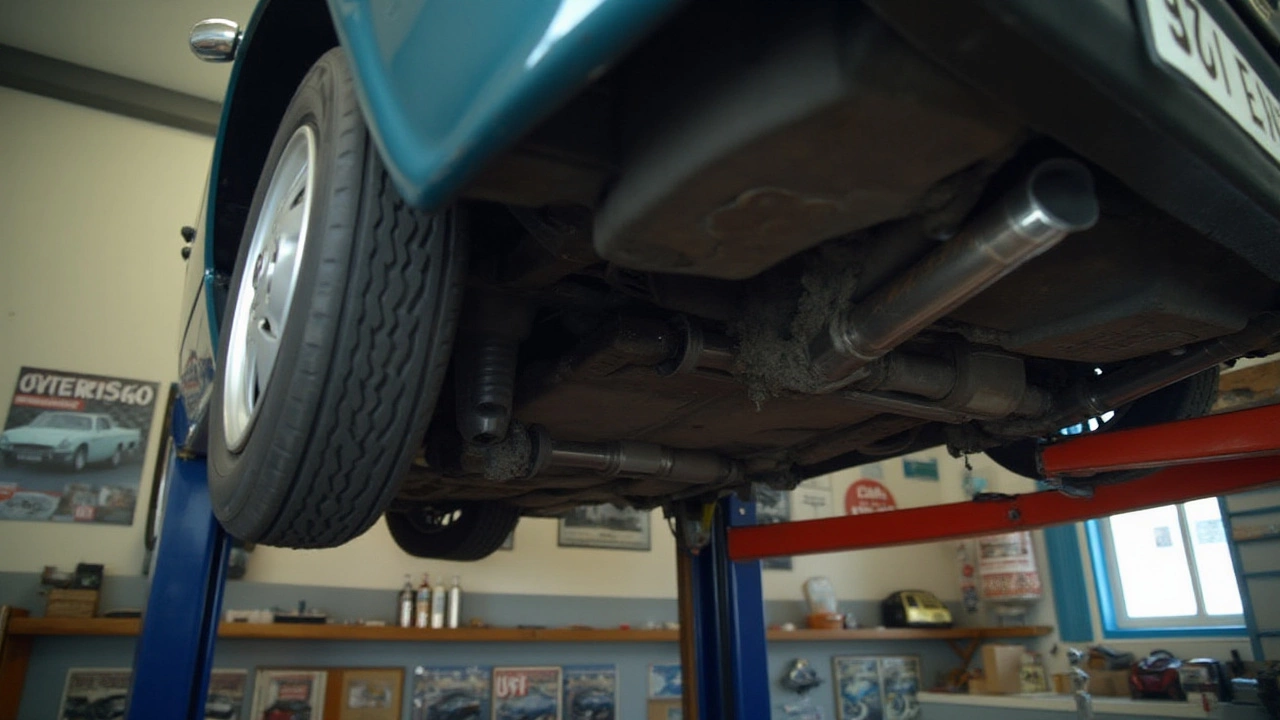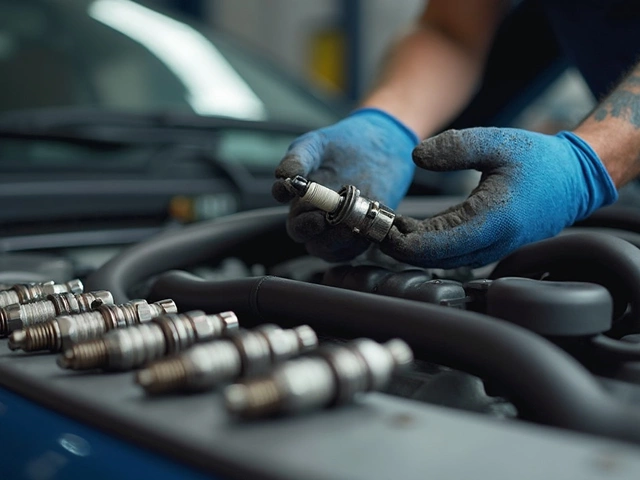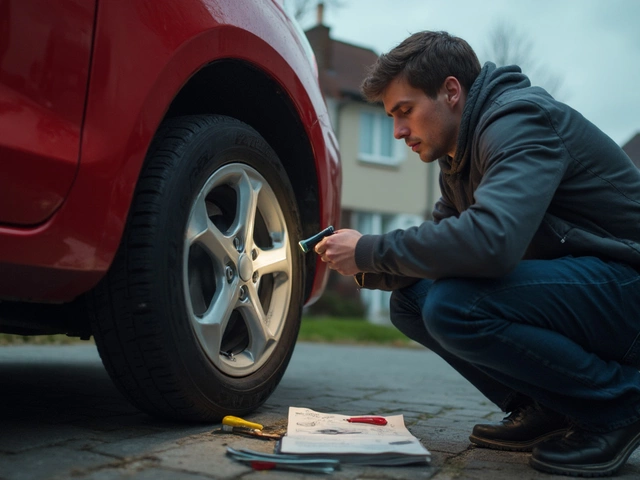From a whisper to a clunk, our cars communicate in a language all their own, especially when something goes awry. One part of your vehicle that’s particularly vocal when things start to go bad are the shock absorbers. These essential components play a vital role in ensuring your ride is smooth, handling is responsive, and most importantly, your safety is uncompromised.
Like a good friend who can't hide emotions, your car too can't mask the sounds of faulty shocks. Learning to recognize these sounds can prevent further damage and costly repairs. With this article, we dive deep into the noises made by malfunctioning shock absorbers and what they mean for your vehicle's overall health.
- Signs and Sounds of Faulty Shocks
- Why Shocks Go Bad
- How Bad Shocks Affect Driving
- Diagnosing Shock Absorber Problems
- Repair and Maintenance Tips
Signs and Sounds of Faulty Shocks
Recognizing the signs and sounds of bad shocks in your car can be likened to developing an ear for the language your vehicle speaks. Each strange noise or unusual handling behavior serves as a warning, signaling that it's time to take a closer look under the hood. One of the most prevalent and telling symptoms of deteriorating shock absorbers is that unmistakable clunking or banging sound, especially noticeable when driving over bumps or uneven surfaces. These sounds aren’t just whims of your car's personality; they're the result of the shocks' inability to properly dampen the impact from the road as they should.
This clunking might be accompanied by a rattling sound, often resulting from the internal components of the shock itself breaking down over time. Along with the auditory signs, a vehicle with bad shock absorbers often exhibits visible symptoms. You might notice excessive bottoming out, where the car seems to dip too low upon impact with speed bumps or potholes. This is a clear indication that the shocks are not providing the necessary support to keep the vehicle steady.
Another sign to watch for is unusual tire wear, often referred to as cupping or scalloping. This pattern occurs because the wheels are not held firmly in contact with the road and tend to bounce unpredictably, leading to uneven tire tread. The cumulative impact of these symptoms not only affects comfort but also jeopardizes safety, making it crucial to address issues with the suspension promptly.
"Ignoring these early warning signs is akin to skipping a heartbeat – it may lead to greater trouble," notes automotive expert James May in his latest column on vehicle maintenance.
Environmental factors and the nature of your driving can also accelerate the wear and tear on your vehicle's shocks. Consistently hauling heavy loads or driving predominantly on rough terrain tends to shorten their life span. It becomes imperative, therefore, for every driver to periodically inspect their car's suspension system, listening for unusual sounds and observing any changes in handling. Early detection prevents minor issues from snowballing into major repairs, thereby saving money and ensuring your driving experience remains smooth and enjoyable.
To further illustrate these points, let's consider that according to a 2023 survey by the National Institute for Automotive Service Excellence, over 40% of cars on the road have at least one degraded shock absorber, which can extend braking distances by up to 20%. This striking statistic highlights why monitoring the health of your car's suspension is not just about longevity, but also about maintaining control in critical driving moments.
For those keen on conducting a basic self-diagnosis, there is a simple test that involves pushing down on each corner of the car. If the vehicle bounces more than two or three times after releasing, this suggests that the shocks might not be dampening as effectively as they should. However, to ensure accuracy and safety, consulting a professional mechanic is always advisable when in doubt. Paying attention to these signs and sounds is not just an exercise in maintaining your vehicle, but a crucial component of responsible car ownership.
Why Shocks Go Bad
Shock absorbers, those unsung heroes beneath your car, quietly toil away at making every journey smooth and stable. But over time, like all things mechanical, they wear down. The primary reason car shocks deteriorate is due to the very nature of their function. Each time you drive over a bump or dip, your shocks compress and rebound to absorb the impact. This process involves a lot of kinetic energy that gradually takes its toll on the components inside them. The hydraulic fluid within the shock absorber heats up as it flows through the valves, making the internal seals and chambers wear down slowly, especially with frequent hard usage or aggressive driving behaviors that heighten the pressures involved. This cyclical stress leads to wear and eventually, the inefficiency of shock performance.
Environmental factors also greatly affect how quickly your vehicle's shocks might degrade. If you're driving in areas with a lot of road salt or sandy conditions, the outer casing of your shock absorbers may begin to corrode, which could inadvertently lead to internal issues. Dirt and debris can also accumulate on the pistons, wear down seals, and cause fluid leaks, resulting in a lack of proper damping. A telling statistic from the automotive repair industry suggests that in regions with harsh winters, the lifespan of shocks can decrease by as much as 35% compared to a more temperate climate.
Moreover, the load that your vehicle regularly carries can dictate the pace at which shocks go bad. Carrying heavy loads on a consistent basis increases the demand placed on the shocks, requiring them to exert more force than they are typically designed to manage. This additional stress can lead to premature wear. To add, the type of roads most frequented plays a significant role – with urban areas filled with potholes and speed bumps accelerating deterioration compared to smooth highways. It’s these cumulative factors that lead to what we commonly perceive as bad shocks.
"Many drivers overlook their car's suspension until something goes awry. Regular inspections can preemptively identify issues," notes Samuel Jones, a seasoned mechanic with over 20 years in automotive repair.It's also worth noting that manufacturing defects, though rare, can exacerbate shock absorber issues. If poorly constructed or made from subpar materials, shock absorbers may fail sooner than expected—a situation that's usually corroborated by recurring replacement needs over a short period. All these aspects illustrate why regular maintenance and attentive care are so crucial in extending the lifespan of your suspension parts.
Regular maintenance and checkups can greatly expand the longevity of shock absorbers. During these checkups, mechanics can assess wear and advise replacements before they evolve into broader issues affecting vehicle maintenance. Ensuring proper air pressure in the tires can also indirectly preserve shocks, as well-inflated tires help to distribute the load evenly, reducing undue pressure on any one shock. Staying informed about what wears down your shocks and taking steps to minimize these wear factors can result in a more comfortable, safe, and reliable driving experience.

How Bad Shocks Affect Driving
Driving with faulty shocks is akin to venturing into a tumultuous sea with a worn-out rudder. The shock absorbers in your car are paramount, dictating how well your vehicle handles the road. When they start failing, the most immediate issue you might notice is a bumpy, uncomfortable ride. This happens because the shocks can no longer absorb the road’s imperfections, leading to excessive bouncing over every bump and pothole. While this discomfort might seem trivial at first, it gradually heralds deeper issues. Poor shocks diminish your control over the vehicle, making it respond sluggishly to steering inputs. This, in turn, can be dangerous, particularly when attempting emergency maneuvers at high speeds or during inclement weather conditions.
Another critical effect of bad shocks is uneven tire wear. With every bump, the tire is forced to momentarily lose contact with the ground, which accelerates wear on certain parts of the tire tread. This not only shortens the lifespan of your tires, thus increasing your maintenance costs, but also reduces the traction your vehicle can achieve. Reduced traction could lead to skids and longer stopping distances. In essence, you might find your car taking an extra few crucial meters before coming to a complete stop, potentially making all the difference in avoiding a collision. Moreover, research suggests that vehicles with faulty suspension systems, including bad shocks, have longer braking distances by up to 20%.
It's also worth considering that bad shocks affect alignment and stability. This can manifest as a pull to one side when driving straight, or a noticeable lean when making turns. Over time, this misalignment can lead to additional stress on suspension parts and the steering components, slowly compounding into structural issues that may rip into your wallet. Someone once said, “A good rider controls his horse, whereas a bad rider is controlled by it.” In the same vein, well-functioning shock absorbers keep you in charge of your ride, while their deteriorating counterparts let the vehicle ride you.
Moreover, the ripple effect of driving with compromised shocks extends to the vehicle's electronics. Modern cars are laced with a host of electronic systems aimed at maintaining stability, such as ABS and traction control. These systems rely on accurate readings from the road to function optimally. When the shock absorbers become compromised, the vehicle’s sensors might receive erratic data, which could cause the electronic systems to take incorrect action. This not only jeopardizes driving safety but might also lead to costly diagnostic solutions that don’t address the root problem.
Finally, don't overlook the toll bad shocks take on your own comfort and health. The constant jarring and vibration might lead to fatigue, which can impair your reaction times. This is significant, particularly for those who drive long distances regularly. Studies observe that drivers navigating roads with bad shocks may experience up to 20% faster fatigue rates compared to when the shocks are in good condition. Thus, paying attention to these
Diagnosing Shock Absorber Problems
When it comes to maintaining the health of your car's suspension system, paying attention to potential shock absorber issues is crucial. Many drivers may not immediately notice the subtle signs of failing shock absorbers, making it important to know what to look for before the problem escalates. A common symptom of bad shocks is an unusual clunking or thumping noise when driving over bumps or particularly rough roads. This noise indicates that the shocks are unable to effectively absorb and dampen the impact, resulting in metal components clashing together. Another sign to watch for is your car exhibiting excessive bouncing after hitting a dip or a bump. This suggests that your shocks are no longer providing the necessary resistance to stabilize the vehicle's motion.
Visual inspection is a fairly straightforward method for diagnosing bad shock absorbers. You might notice a noticeable tilt or sagging at one corner of the vehicle, suggesting uneven wear or a failing shock. Similarly, the presence of oil or hydraulic fluid leaks on or around the shock absorber indicates a potentially compromised seal, which demands immediate attention. Pay attention to your tire wear patterns as well. Uneven or cupped tire wear often hints at suspension issues, including the possibility of worn-out shocks. Listen to your car when braking hard too; if the car noses down significantly, it might be a sign that the shock absorbers are not providing adequate support.
Simple Tests to Conduct at Home
If you suspect issues with your shock absorbers but want some confirmation before heading to the mechanic, there are simple tests you can perform. The "bounce test" is one such method, where you can push down firmly on each corner of your car and observe how it rebounds. A car with healthy shocks will quickly settle after a couple of bounces, whereas one with failing shocks will continue to oscillate. Although this method won't pinpoint specific problems, it can give you an indication of whether further professional inspection is needed. Keep in mind, though, that the symptoms of bad shocks can mimic other suspension problems, like issues with the springs or bushings, so professional evaluation is key.
The quest to keep your vehicle on the road and functioning smoothly is one every car owner shares. Many industry experts suggest taking a pragmatic approach when diagnosing car shocks. A spokesperson from the UK’s AA motoring association once noted, "A quiet ride isn’t always a smooth ride. You may not feel the problem until it’s too late—stay vigilant." Therefore, it’s important to stay proactive and learn the language of your car's mechanical sounds. Addressing these issues early can not only save money but also ensure the continued safety and reliability of your vehicle in the longer term.

Repair and Maintenance Tips
Maintenance of your car's shocks can significantly extend their lifespan, ensuring a smooth ride and safe handling. Start by routinely inspecting your vehicle's suspension components. Keep an eye out for physical damage such as dents, leaks, or corrosion, which are often telltale signs of worn shocks. Anecdotal evidence from mechanics suggests that shock absorbers should operate in near silence; any clanking, rattling, or persistent squealing noises could indicate a problem. Pay attention to how your car handles on the road. If it sways or bounces excessively on rough terrain, the shocks may be worn.
Preventive measures can help mitigate damage, such as ensuring that tires are properly inflated and wheels are aligned. It's a simple yet effective way to reduce stress on the suspension parts. Furthermore, regular tire rotation can facilitate even tire wear, contributing to better shock performance. If you find yourself unsure about the condition of your shocks, consulting a professional mechanic can provide insight. As the old adage goes, 'A stitch in time saves nine.' Taking quick action upon noticing early symptoms can prevent more extensive damage.
Performing small tests at home can also help pinpoint bad shocks. When your vehicle is parked, try pressing down firmly on the front and rear fenders; a healthy suspension should rebound and settle immediately. Excessive bouncing suggests waning shocks. Another practical tip is to check for visible fluid leaks, which are common indicators of shock absorber failure.
"Regular maintenance is to vehicles what regular check-ups are to humans. Ignoring early signs in either could lead to serious issues down the road," says Robert Anderson, a renowned automotive engineer.
If repairs are necessary, consider replacing bad shocks in pairs—either the front two or rear two—to maintain balance. When installing new shocks, follow the manufacturer's specifications and use quality components to ensure longevity. It’s also wise to review the vehicle's manual for recommended service intervals specific to your car model. Proper disposal of worn shocks is important as well. These components often contain oil and other chemicals, so they must be discarded responsibly at designated recycling centers.
When maintaining your vehicle's suspension, remember tool selection is crucial. Having the right tools on hand can make the process smoother. Typical tools include wrenches, jacks and jack stands, and torque wrenches for precise application. Safety precautions are essential: always work on a stable surface and use jack stands to prevent accidents.
Finally, staying informed about the health of your suspension system helps avoid unnecessary hurdles on the road. An educated driver is less likely to face the inconvenience and dangers of driving with bad shocks. By adopting a proactive approach to vehicle maintenance, you not only bolster the lifespan of your shocks but enhance your journey behind the wheel.






